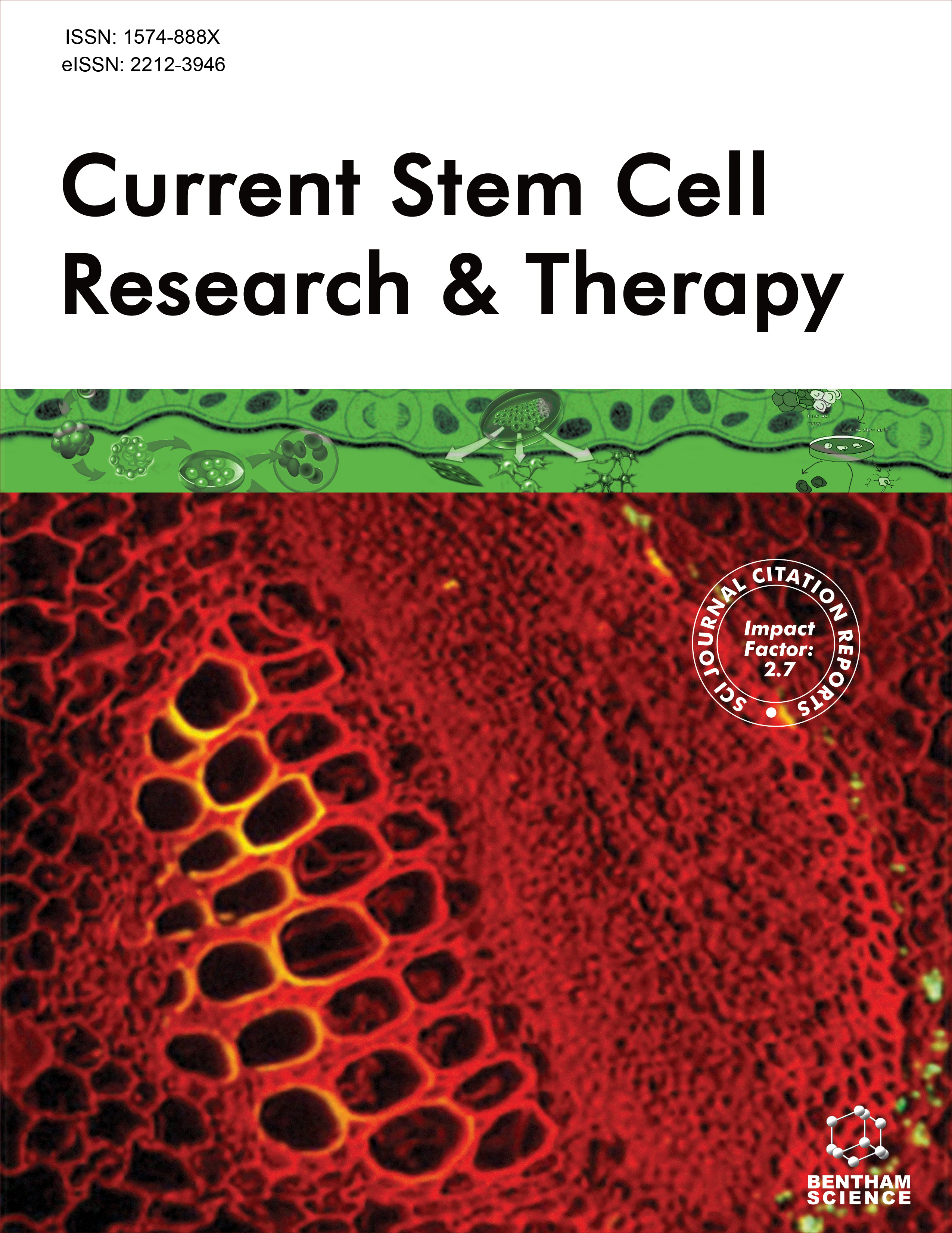- Home
- A-Z Publications
- Current Stem Cell Research & Therapy
- Previous Issues
- Volume 14, Issue 1, 2019
Current Stem Cell Research & Therapy - Volume 14, Issue 1, 2019
Volume 14, Issue 1, 2019
-
-
Recent Advances of Useful Cell Sources in the Periodontal Regeneration
More LessAuthors: Young-Dan Cho, Kyoung-Hwa Kim, Hyun-Mo Ryoo, Yong-Moo Lee, Young Ku and Yang-Jo SeolBackground: Periodontitis is an inflammatory disease that can result in destruction of the tooth attachment apparatus. Therefore, periodontal tissue regeneration is currently an important focus of research in the field. Approaches using stem cells and reprogrammed cells, such as induced pluripotent stem cells (iPSCs) or trans-differentiated cells, represent the cutting edge in periodontal regeneration, and have led to many Read More
-
-
-
Paracrine Mechanisms Involved in Mesenchymal Stem Cell Differentiation into Cardiomyocytes
More LessAuthors: Maryam Farzaneh, Fatemeh Rahimi, Masoumeh Alishahi and Seyed E. KhoshnamCardiovascular disease (CVD) is one of the world-wide healthcare problem that involves the heart or blood vessels. CVD includes myocardial infarction and coronary artery diseases (CAD). Dysfunctional myocardial cells are leading causes of low cardiac output or ventricular dysfunction after cardiac arrest and may contribute to the progression of CVD which could not generate new cardiomyocytes in human adult heart. Read More
-
-
-
Mesenchymal Stromal Cells and Natural Killer Cells: A Complex Story of Love and Hate
More LessMesenchymal stromal cells (MSCs), characterized by both multidifferentiation potential and potent immunomodulatory capacity, represent a promising, safe and powerful cell based-therapy for repairing tissue damage and/or treating diseases associated with aberrant immune responses. Natural killer (NK) cells are granular lymphocytes of the innate immune system that function alone or in combination with other immune Read More
-
-
-
The Clinical Trials of Mesenchymal Stem Cell Therapy in Skin Diseases: An Update and Concise Review
More LessThe skin is one of the crucial body organs with anatomy and physiology linked to various disorders including congenital and acquired diseases. Nowadays, mesenchymal stem cell (MSCs)- based therapy has appeared as a promising therapeutic field, in which many see opportunities to cure the costliest and incurable diseases. However, one question to be asked is that if the use of MSCs in clinical trials studies and diseases tr Read More
-
-
-
The Potential Roles of Tendon Stem/Progenitor Cells in Tendon Aging
More LessAuthors: Yingjuan Li, Guangchun Dai, Liu Shi, Yucheng Lin, Minhao Chen, Gang Li and Yunfeng RuiAging is a key dangerous factor for the occurrence and severity of tendon injury, but the exact cognition of the relationship is elusive at present. More previous studies suggest age-related changes occur at tendon mechanical properties, structure and composition, but the pathological alternations may be overlooked, which might be a cause for the structure and function variations, and even speed up the progress of ag Read More
-
-
-
Mesenchymal Stem Cells, Immune Cells and Tumor Cells Crosstalk: A Sinister Triangle in the Tumor Microenvironment
More LessAuthors: Mahboobeh Razmkhah, Shabnam Abtahi and Abbas GhaderiMesenchymal Stem Cells [MSCs] are a heterogeneous population of fibroblast-like cells which maintain self-renewability and pluripotency. Many studies have demonstrated the immunomodulatory effects of MSCs on the innate and adaptive immune cells. As a result of interactions with tumor cells, microenvironment and immune-stimulating milieu, MSCs contribute to tumor progression by several mechanisms, including sustai Read More
-
-
-
CellSaic, A Cell Aggregate-Like Technology Using Recombinant Peptide Pieces for MSC Transplantation
More LessIn the field of stem cell therapy, research on the application of mesenchymal stem cells (MSCs) has flourished because of the various functions. On the other hand, research on the method of cell transplantation has developed from the administration of cell suspensions to cell-sheet engineering and 3D technology. In the trend, a cell transplantation platform named CellSaic, which is a combination of xeno-free recombinant scaffol Read More
-
-
-
Differentiation of Pluripotent Stem Cells into Nucleus Pulposus Progenitor Cells for Intervertebral Disc Regeneration
More LessAuthors: Kaishun Xia, Zhe Gong, Jian Zhu, Wei Yu, Yitian Wang, Junjie Wang, Ankai Xu, Xiaopeng Zhou, Huimin Tao, Fangcai Li and Chengzhen LiangLow back pain (LBP) is one of the world's most common musculoskeletal diseases and is frequently associated with intervertebral disc degeneration (IDD). While the main cause of IDD is commonly attributed to a reduced number of nucleus pulposus (NP) cells, current treatment strategies (both surgical and more conservative) fail to replenish NP cells or reverse the pathology. Cell replacement therapies are an attractive alternati Read More
-
-
-
Ductal Cell Reprogramming to Insulin-Producing Beta-Like Cells as a Potential Beta Cell Replacement Source for Chronic Pancreatitis
More LessIslet cell auto-transplantation is a novel strategy for maintaining blood glucose levels and improving the quality of life in patients with chronic pancreatitis (CP). Despite the many recent advances associated with this therapy, obtaining a good yield of islet infusate still remains a pressing challenge. Reprogramming technology, by making use of the pancreatic exocrine compartment, can open the possibility of generating n Read More
-
Volumes & issues
-
Volume 20 (2025)
-
Volume 19 (2024)
-
Volume 18 (2023)
-
Volume 17 (2022)
-
Volume 16 (2021)
-
Volume 15 (2020)
-
Volume 14 (2019)
-
Volume 13 (2018)
-
Volume 12 (2017)
-
Volume 11 (2016)
-
Volume 10 (2015)
-
Volume 9 (2014)
-
Volume 8 (2013)
-
Volume 7 (2012)
-
Volume 6 (2011)
-
Volume 5 (2010)
-
Volume 4 (2009)
-
Volume 3 (2008)
-
Volume 2 (2007)
-
Volume 1 (2006)
Most Read This Month
Article
content/journals/cscr
Journal
10
5
false
en


